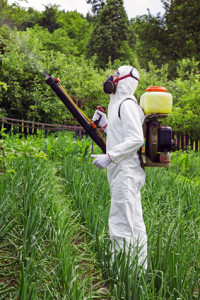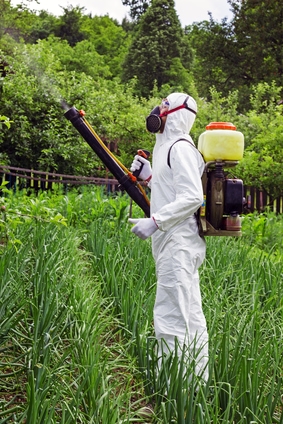 This article is condensed with permission from Pesticides and You, the quarterly publication of Beyond Pesticides/National Coalition Against the Misuse of Pesticides (NCAMP).
This article is condensed with permission from Pesticides and You, the quarterly publication of Beyond Pesticides/National Coalition Against the Misuse of Pesticides (NCAMP).
Myth: Pesticides pose no risk to the health of children.
Fact: Pesticide poisoning of children and adults is common.
Nausea, dizziness, respiratory problems, headaches, rashes, and mental disorientation may appear even when a pesticide is applied according to label directions. Low levels of pesticide exposure can adversely affect a child’s neurological, respiratory, immune and endocrine system. Of the 48 pesticides commonly used in schools, 22 can cause cancer, 26 can affect reproduction, 31 are nervous system poisons and 16 can cause birth defects.
Myth: Without pesticides, pests pose a serious health and safety risk.
Fact: Pest problems can be effectively managed without toxic pesticides.
The pro-pesticide lobby wants people to think that if we stop using toxic pesticides, our homes, school buildings and lawns will be overrun by disease-carrying pests and weeds. Not true. Most insect and weed pests, though unsightly or a nuisance, do not threaten children¹s health. We should never expose ourselves or our children to harmful pesticides for cosmetic reasons alone.
Myth: Pesticides are a vital ingredient in any pest management program.
Fact: Safer alternatives are available.
Alternatives to conventional hazardous pesticides are proving successful in over 100 school districts around the country. Non-toxic and least-toxic control products are a major growth area and new materials and devices enter the marketplace every day.
Many people now choose Integrated Pest Management (IPM), which, unlike conventional chemical-intensive methods, focuses on prevention and monitoring. IPM uses sanitation, structural repairs, mechanical and biological interventions, non-chemical methods and, only when unavoidable, least-toxic pesticides.
Myth: IPM programs are too costly.
Fact: IPM is cheaper in the long term.
Initial investments in IPM training, equipment, building repair, or hiring an IPM coordinator lead to savings later on. Chemical-intensive programs only prove less expensive in the short-term. The health of our children is not worth short-term economic savings.
A successful IPM program in Montgomery County, MD, covering 200 sites, reduced pesticide use from 5,000 applications in 1985 to none four years later, saving the district $1,800 per school and an additional $30,000 at the county’s food service warehouse.
Myth: Pesticide risks are tested before government approval.
Fact: Most pesticides registered for use by The Environmental Protection Agency (EPA) have never been fully tested.
No one knows the full range of potential human health risk from pesticides for cancer, birth defects, genetic damage and reproductive, neurological and endocrine disorders.
In June 2000, EPA and Dow AgroSciences agreed to phase out school use of Dursban (chlorpyrifos, a commonly used insecticide advertised as safe for the past 30 years) because of its high risk to children. Even this agreement between EPA and the manufacturer allows continued use of Dursban until existing stocks are exhausted, leaving people at risk.
EPA’s procedure for evaluating adverse effects by testing laboratory animals does not prove these products to be safe for children. Lack of disclosure requirements, insufficient data requirements, and inadequate testing make accurate estimates of the danger of pesticide exposure impossible.
Myth: As long as the pesticide is applied to an unoccupied area, and people return only after it has dried, they will be safe.
Fact: Pesticide residues can linger for days.
Pesticides should never be applied in areas likely to be inhabited within 24 hours. Airborne concentrations of seven insecticides were tested three days following their application in separate rooms. Six of the seven pesticides left residues behind through the third day. A 1998 study found that Dursban accumulated on furniture, toys and other surfaces up to two weeks after application.
Some least-toxic pesticides: boric acid and disodium octobrate tetrahydrate, silica gels, diatomaceous earth, nonvolatile insect and rodent baits in tamper resistant containers or for crack and crevice treatment only, microbe based insecticides, biological, living control agents, and materials for which the inert ingredients are nontoxic and disclosed.
To learn more: Contact NCAMP 202-543-5450 or <http://www.beyondpesticides.org>. Ask for their bimonthly bulletin, School Pesticide Monitor, and an NCAMP Factsheet: 48 Commonly Used Pesticides in Schools. Read Home Safe Home by Deborah Dadd.
For lawns, subscribe to Organic Lawn & Garden Resource Directory published by the Neighborhood Network 9516 541-43210. Their biannual survey recommends stores and mail order catalogs offering wide selections of safe lawn and garden care products.
For home pests such as fleas, dust mites, roaches and wasps, get odorless non-toxic products from Fleabusters: 800-6NO-FLEA or <http://www.fleabuster.com>
